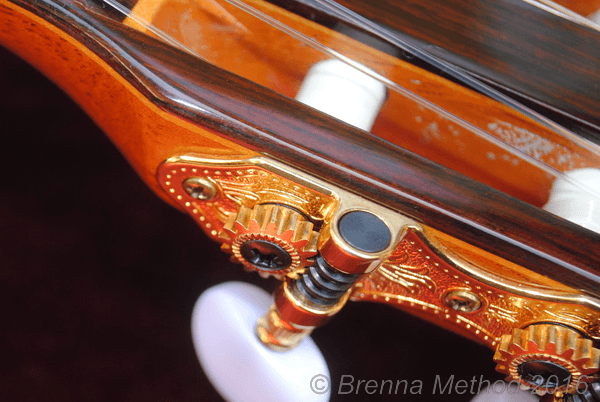The Trick
Cool trick that’s embedded in the nature of guitar: wringing exotic new sounds from shopworn guitar chords. It’s simple to accomplish and opens the gates to new sonic worlds. It’s a songwriter’s paradise, and you don’t have to learn any new chord shapes to do it.
C chord: Grab and Go
Start with an open C chord.
 Now move it up two frets so your ring finger is on the 5th fret, keeping the same exact chord shape and fingering.You get a major chord with a beguiling twist. It’s a D chord with a seductive dissonance resulting from both the major 3rd and an added perfect 4th ringing together a half step apart (on the 4th and 3rd strings). Besides strumming it, arpeggiate the chord, playing each note in sequence. This makes the character of the chord explode from your guitar. Now move the chord shape up another 3 frets and play. Move 2 frets higher again (ring finger on 10th fret); and again 2 more; and finally 1 more fret, so your ring finger is now on the 5th string at the 13th fret. At each new position you play a major type chord with a distinctly different color and emotional resonance. You could easily write a song with only these guitar chords, and it’ll sound worlds away from anything you’ve played or written with conventional open position chords.
Now move it up two frets so your ring finger is on the 5th fret, keeping the same exact chord shape and fingering.You get a major chord with a beguiling twist. It’s a D chord with a seductive dissonance resulting from both the major 3rd and an added perfect 4th ringing together a half step apart (on the 4th and 3rd strings). Besides strumming it, arpeggiate the chord, playing each note in sequence. This makes the character of the chord explode from your guitar. Now move the chord shape up another 3 frets and play. Move 2 frets higher again (ring finger on 10th fret); and again 2 more; and finally 1 more fret, so your ring finger is now on the 5th string at the 13th fret. At each new position you play a major type chord with a distinctly different color and emotional resonance. You could easily write a song with only these guitar chords, and it’ll sound worlds away from anything you’ve played or written with conventional open position chords.
The shifts in quality and character that you hear as you move a guitar chord up the fretboard occur because fretted notes are changing while open string pitches remain the same. A rainbow of colors emerges from new interval combinations among the notes of each chord. Since ordinary open position chords contain only chord tones, which are highly consonant and stable, they’re rather plain sounding. Moving the chord shape up the fretboard adds melodic tensions that shimmer and shine.
More Chords
Try another chord, the open E major chord:
 When you move it up one fret you will discover an exotic, spanish sounding F chord. Move it up another fret and you’ve got a Lydian chord, a sound often used to evoke childlike wonder. Experiment with moving further up the neck: you’ll find at least six more positions that create exotic and pleasing new sounds. Experiment with transitioning among these new “E-shape” chords while you strum a rhythm. The variety of shifting colors is perfectly balanced by the stability of the fretted notes.
When you move it up one fret you will discover an exotic, spanish sounding F chord. Move it up another fret and you’ve got a Lydian chord, a sound often used to evoke childlike wonder. Experiment with moving further up the neck: you’ll find at least six more positions that create exotic and pleasing new sounds. Experiment with transitioning among these new “E-shape” chords while you strum a rhythm. The variety of shifting colors is perfectly balanced by the stability of the fretted notes.
Now try a typical three finger power chord:
 Play all 6 strings and you’ve got a super resonant E power chord. Now take this base shape and move it around the guitar fretboard. With the lowest note at the 5th fret you’ll hear a fresh version of D with added 6 and 9. At the 4th fret you get a spacious C# minor 7 add 11. The 3rd fret yields a poetic Cmaj7, and the 2nd fret produces a wide open Bsus4.
Play all 6 strings and you’ve got a super resonant E power chord. Now take this base shape and move it around the guitar fretboard. With the lowest note at the 5th fret you’ll hear a fresh version of D with added 6 and 9. At the 4th fret you get a spacious C# minor 7 add 11. The 3rd fret yields a poetic Cmaj7, and the 2nd fret produces a wide open Bsus4.
Ready to Fly
By now you’ve experienced the expanded range and unique poetic resonance and of these simple, familiar chord shapes in new positions. Every chord shape that includes open strings is the seed of a whole family of chords when you move it around the fretboard, so the size and variety of the sound palette you can create is huge.
Spice Up Those Drills
Here’s another great application for these chords: turning monotonous right hand studies into compelling music. Guitarists have been using 120 Right Hand Studies by Giuliani for hundreds of years to master the dexterity required for classical and finger style guitar. But the crushing boredom of playing each study on an alternating C and G7 open chord progression leave most players feeling cold. Substitute these colorful new chords instead and its goodbye boring drills, hello inspiration!
© 2013 Brenna Method (updated January 2018)

